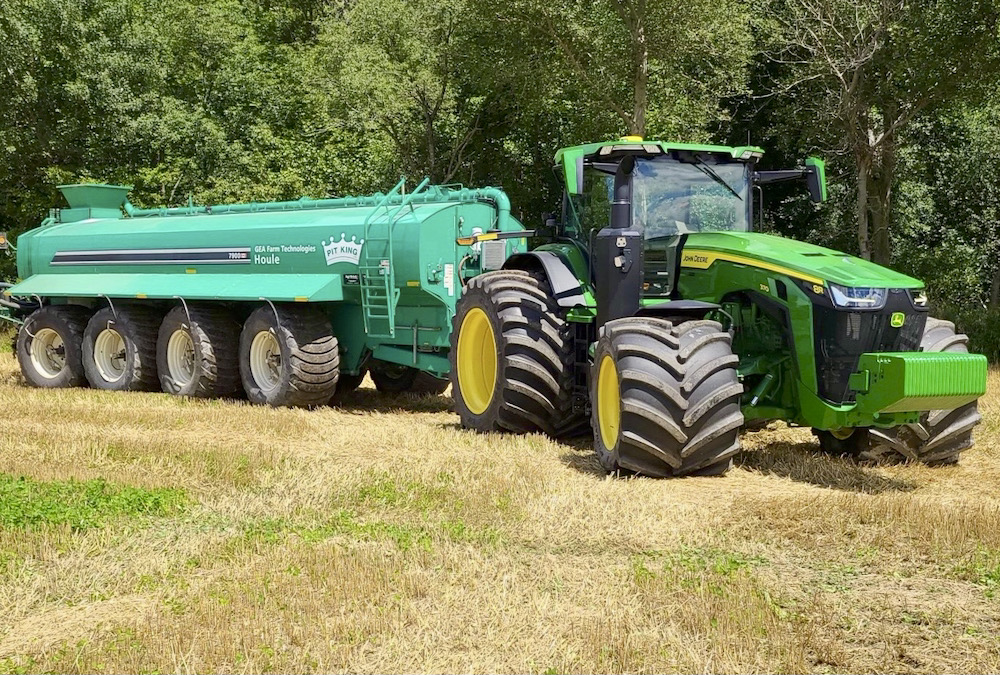Haulers face challenges from inattentive, aggressive drivers

The 2021 planting and harvest seasons saw a return to normal, when compared to the unexpected calm of 2020. But when it comes to traffic on rural roadways, it might be worse than normal.
That’s the observation of Pumped Environmental Services owner Larry Bearinger, whose Tavistock-based business pumps, transports and custom-applies liquid manure on farms across southwestern Ontario. Bearinger spoke during a panel discussion about do-it-yourself applicator innovations at the recent North American Manure Expo.
Why it matters: Agricultural equipment is a fact of life on many Ontario roadways, so non-farm and farming road users must learn to safely co-exist.
Bearinger said in the spring and summer of 2020, rural roadways were almost free of non-farm traffic as commuters toiled at home and families opted for “staycations” instead of day trips or holidays.
This spring and summer, however, made up for the serenity. Bearinger cited unsafe passing and inattentive drivers as major challenges he and his employees faced this year.
The Manure Expo also hosted a session entitled “From agitation to application in the field: What you need to know about transporting manure safely.” In that session, Husky Farm Equipment president Walter Grose said rear-end collisions typically result in charges for following too closely. But if an inattentive driver runs into the back of a farm vehicle that doesn’t have all the required lighting and slow-moving vehicle signage, the blame can shift to the farm vehicle driver.
Fellow presenter Cheryl Skjolaas, from the University of Wisconsin’s Center for Agricultural Safety and Health, said a high percentage of automobile/farm vehicle collisions occur during daylight hours. Farmers should consider investing in newer-style lighting technology that makes vehicles more visible during daylight.
Slow Moving Vehicle decals are inexpensive and should be replaced if visibility or reflectivity is decreased.
Southern Ontario custom applicator Ron Bults agreed with Bearinger’s observation about the frequency of aggressive and inattentive driving in 2021 on rural roads.
“It’s frustrating. It’s very frustrating,” he said, adding that his company, Alma-based Pit King, has endured two recent rear-end collisions in which their operators were not charged. One of those collisions had serious consequences for the other driver.
Bults said his company recently decided, on a trial basis, to replace the dual tires on one of its tractors with single 1,400-millimetre-wide low sidewall (LSW) tires.
Pit King’s equipment has the latest lighting but it isn’t always possible to yield the centre of the roadway to oncoming traffic, as is the law, without driving off the pavement on the right.
“With the duals, we’re too wide so we’re on the shoulder of the road making all this dust,” Bults said. It can be hard for drivers behind the tractor to see what’s ahead.
The 1,400 LSWs are new for Pit King. Bults said they have performed well in the St. Thomas area while pulling the injector on “some real hard dirt.”
A few days later, Bults confirmed the new tires also passed the test on hilly terrain. He said he has seen wider single tires used in the U.S. but doesn’t know of any Canadian manure haulers who have tried them.
Total width in contact with the ground is only slightly less than the commonly used dual 710-mm tires, so compaction is unlikely to be a concern with the 1,400s and he has personally confirmed they stir up less dust.
But “we want to make sure they’re good in all applications,” Bults said.
The do-it-yourself innovation highlighted by Bearinger also has road safety implications.
He modified a truck engine and transmission to haul a manure pit pump to and from job sites and operate the pump at 1,500 rpm. He said it’s more efficient than using a tractor to run the pump.
In their session, Grose and Skjolaas offered tips for lowering the risk of collisions and the risk of being found at fault from collisions:
- Watch for signs of fatigue and, if possible, switch tasks with other trained employees to break up routine.
- Take regular breaks and fuel the body properly with good nutrition.
- Know the regulations and do “circle checks” at the start of every workday. Include the safety chain, safety clip on the draw bolt, tire inflation, wheel nut tightness, lights and SMV signs. Results from these checks should be recorded and archived.
- If the travel route has points where it’s difficult or impossible to yield the centre of the roadway, have a plan. Aim to travel during low-traffic times and determine how you will handle meeting another vehicle at that location.
- Know the dimensions and weights of equipment, and the weight and height limits of bridges and overpasses on the route.
- Use a tractor that can safely tow and brake for the equipment or invest in effective braking systems. “When you push the limit, the brakes in the tractor are going to fail,” Grose cautioned.
- If you had a late party night and an early morning start, are you a suitable operator? Impaired charges and vehicle impoundment can result.
- A good public image makes it less likely you will be blamed for a spill or collision. Carry traffic pylons and flag people when necessary. As much as possible, keep roads and equipment clean. Have a contingency plan in the event of a spill, including who to call and how to secure the necessary cleanup equipment.
Source: Farmtario.com

